Plan a trip to the Algarve in winter. Visit Portugal in December. Discover things to do in Southern Portugal.
Have you considered spending time in Portugal in December?
The Algarve in the winter months is an ideal destination in Southern Portugal: the weather is not too cold (definitely above freezing) plus the region is quiet and relaxing.
As an added bonus, you can avoid throngs of tourists by visiting Portugal in winter. We've had the pleasure of visiting the Algarve twice now in December. Read on for ideas about things to do in the Algarve and places to see on an Algarve Portugal road trip.
Getting to the Algarve
There are a few different ways to get to the Algarve: by plane, train, bus, or car.
How far is the Algarve from Lisbon? It takes about 3 hours to drive to the Algarve from the Portuguese capital.
You can get to the Algarve from Lisbon by train as well. It takes between 3-4 hours to get between Lisbon and the southern coast of Portugal by rail depending on the number of stops the train makes. The main train stops in the Algarve are Loulé, Albufeira, and Faro.
If you want to fly directly to the Algarve from points in Europe, both Ryanair and Easyjet fly directly to Faro. If you are visiting Portugal from further afield, you can also catch a connecting flight from Lisbon to Faro.
Rede Espressos and FlixBus both operate services between Lisbon and Faro. Taking the bus is probably your cheapest option to get to the Algarve with tickets purchased well in advance selling for as little as 5 EUR.
Of course, the most convenient way to get to and around the Algarve is to rent a car. Renting a car gives maximum flexibility to visit the charming towns and villages all along the coast.
We've personally used three different modes of transportation to get to and around the Algarve. On our first trip (before moving to Portugal), we flew from Dublin direct to Faro on Ryanair.
We rented a car at Faro Airport so that we could more easily get around on our trip. We took the train from Faro to Lisbon for Christmas on that same trip. On our most recent trip, we rented a car from Hertz in Lisbon near Marquês de Pombal and drove down to the Algarve coast from there.
Getting Around the Algarve
Renting a car is essential if you want to explore extensively in the Algarve. There is a high quality motorway that runs across the Algarve from end to end. If you drove the A22 from end to end, it would take about 2 hours (one way).
Note that there are tolls all along the route and you can't pay with cash. Make sure your rental car has an activated toll transponder to avoid any hassle. You'll pay between 0.25 EUR and 1.30 EUR for driving certain segments of the A22 motorway.
Make sure to check with your rental car company to understand their terms and conditions if you plan to drive across the border into Spain. Many rental car companies apply a daily surcharge for the duration of your rental if you take the car across the border.
In theory, you could get around the Algarve by train. For example, there is a train that runs from Faro to Vila Real de Santo Antonio. The train runs less than every hour and the journey takes up to one hour and 15 minutes. You can drive that distance in about 50 minutes and have the flexibility to stop and explore in more places along the way.
Unless you want to "fly and flop" at a resort in the Algarve (I'm not judging you, that's just not my travel style) make sure you rent a car.
Where to Stay in the Algarve
The Algarve is a pretty big place and stretches from Sagres in the west all the way to the Spanish border in the east all along the Southern Coast of Portugal. We have stayed in three different places on our two trips to the Algarve.
Quinta do Caracol
On our first trip to the Algarve, we checked in to Quinta do Caracol, a family run resort in Tavira. We think the place used to be a snail farm before it was turned into a hotel. In the low season in mid-December, expect to pay less than 100 EUR a night.
The grounds were lovely and featured whitewashed buildings with blue and yellow trim, lush vegetation and citrus, and even a swimming pool. All the rooms have names.
We were whisked into 'Amor Perfeito' (Perfect Love) for our stay. We even had a little table and bench outside our room to sit outside -- unfortunately, it was bit cold and rainy during the time we were there so we didn't avail much of the outdoor elements of the property.
Breakfast was one of the highlights of our stay. The breakfast room featured a roaring wood fire. We were served freshly squeezed orange juice from fruit grown on the property.
We also got our first taste of traditional Portuguese Pastel de Nata, Portugal's famous cream custard tarts. The Quinta do Caracol was an excellent home base for exploring the Algarve.
Grand House in Vila Real de Santo Antonio
If you are looking for a splurge in the Algarve with period atmosphere, Grand House in Vila Real de Santo Antonio is a great pick. The building itself dates back to the 1920s. Hotel Guadiana, as it was known at the time, is believed to be the oldest hotel in Southern Portugal.
After its heyday, the building fell into disrepair and was resurrected to its former glory as Grand House in 2018. With just 26 rooms, you can expect a personalized luxury experience. Enjoy Portuguese sparkling wine with the breakfast included in your room rate.
Make time for a gin and tonic at the sleek wooden bar or just sit for a spell in one of the atmospheric parlors on the first floor. We chose to ate a gourmet tasting menu at the Grand House restaurant as a treat for our anniversary.
We especially liked the proximity of the hotel to the Spanish border. At this time of year, you can pop across the Guadiana River and into Spain for seasonal polvorones and mantecados. There is a Mercadona about a 15 minute drive from Grand House.
Grand House cost about 300 EUR a night during the low season in the Algarve in mid-December.
Tivoli Carvoeiro
A more budget-minded option with great amenities in the Algarve in December is the Tivoli Carvoeiro Hotel and Resort. We paid about 150 EUR per night in mid-December. Our room had a beautiful ocean view and breakfast was included.
Take some time to explore the extensive grounds which include an outdoor pool and access to the nearby cliffs and caves. Grab a sunset drink on the terrace if the winter weather in the Algarve isn't too chilly.
The One Restaurant on-site features a high-end multi-course tasting menu with wine pairings. It's worth booking a table if you are celebrating a special occasion or if you simply want to treat yourself to a fine Portuguese meal.
If you are driving to Carvoeiro, the roads to get here from the motorway are not for the faint of heart. Pro-tip: Google Maps will give you a couple of different options. Use Google Street View to get a sense of which route is better. A couple of the roads that we traversed were barely wide enough for a single car to fit. It reminded me of some of our self-drives in rural Ireland.
Vila Real de Santo António (VRSA)
Vila Real de Santo António is situated on the far eastern edge of the Algarve near the Spanish border. If you visit in December like we did, you'll be treated to a small Christmas market on Praça Marquês de Pombal.
Did you know that VRSA is home to the largest nativity scene in Portugal? Pay just 1 EUR for admission and take some time to explore the intricate scene.
I like to read the signs surrounding various attractions. You never know what interesting nuggets of information you might uncover. One of the signs at the VRSA crib was titled "The Cagón or Caganer". What is a Caganer?
"It is a statuette that was usually placed in the nativity scene in Catalonia, Valencia and Canary Islands. The statuette (a peasant with red cap) was hiding behind a shrub or tree to make poop. This tradition emerged at the end of the seventeenth century with a baroque cultural and artistic movement."
After reading this sign, I just had to search and search until I found him hiding behind a bush.
Vila Real de Santo António is also known for birdwatching. You'll find various seabirds and potentially flamingos on the nearby salt pans. Unfortunately, we didn't see any flamingos on our trip to the Algarve in December.
Park near the ALDI on the outskirts of VRSA town and take a hike through Esteiro da Carrasqueira. You'll find modern art sculptures and birdwatching opportunities on this relaxing walk. Note, the trail to the Observatório gets muddy when it's wet so time your visit for nicer weather if you can.
Walk toward the lighthouse: Farolim de Vila Real de Santo António for a windswept walk along the beach. The beach is about a 40 minute walk from the center of VRSA. You can drive yourself or avail of shuttle service if you stay at Grand House like we did.
The Grand House Beach Club is near the beach hike. We decided to stop in for a cocktail after our walk.
Drive yourself to neighboring Monte Gordo and have a rooftop drink at one of the local bars as you watch the sunset. At the far end of the boardwalk, you'll find local fishing boats with brightly colored flags on the beaches in the evening.
Things to Do in Tavira Portugal in Winter
I knew I would like Tavira when I walked down a street past a crumbling tile facade and saw an old woman in a colorful headscarf looking our her window.Our eyes met and she smiled and nodded as we walked by in the rain. Our first order of business was to find something to eat. It was after 3 pm so most lunch places were closed.
We found a small snack bar filled with locals (rowdy but harmless) having a bite to eat and drinking beer. We don't speak Portuguese other than a few pleasantries that we learned for the trip so we pointed to a knish type item (filled with pork).
We rounded out the meal with a bottle of Sagres beer (cost about a euro) and some hot sandwiches. Yum! Continuing on, we couldn't resist stopping at Pasteleria Tavirense for an espresso and slice of checkerboard cake. The cake was super light and airy -- totally unexpected.
Just like Spain, I liked how restaurants in Portugal print their name and contact information on their napkins as a sort of calling card.
We arrived at the River Gilão and admired Tavira's well-preserved traditional Algarve architecture reflected in the water. We stopped into Mercado da Ribeira and admired the different crafts and baked goods on offer. There were also a number of creative Christmas trees on display from a local school.
We arrived at the River Gilão and admired Tavira's well-preserved traditional Algarve architecture reflected in the water. We stopped into Mercado da Ribeira and admired the different crafts and baked goods on offer. There were also a number of creative Christmas trees on display from a local school.
We walked back outside and were greeted by a colorful rowboat floating on the water. We crossed the river and admired the Ponte Romana (Roman Bridge) further upstream leading into the formerly walled section of town. Tavira enchanted us with its colorful tile work and ornate door knockers.
We stopped into a local grocery store and picked up a bottle of Vinho Verde (young white wine) for later before heading back to Quinta do Caracol for a siesta before supper. We walked about 3.6 miles exploring Tavira.
We revisited Tavira on our second trip to the Algarve and we found that it is just as delightful for repeat visitors.
I've developed an obsession with photographing doors between our first and second trips. The doors in Tavira are some of the best I've encountered in all of Portugal!
Pay a visit to Tavira Romana near Ponte Antiga de Tavira. This cafe and bottle shop sells wines from across the Algarve. Steep in the atmosphere of the historic stained glass windows.
Tavira is famous for aguardente and more specifically Medronho. We bought a nice bottle of local aguardente for about 40 EUR. The drink immediately made me think "Portuguese Whiskey!"
We grabbed coffee and cake at a local cafe while locals sat riveted in front of a television watching a football match.
My favorite part about our second visit to Tavira was the opportunity to visit Castelo de Tavira, the ruins of an 11th century castle surrounding a lush garden.
We learned that Tavira Castle dates back to the 10th century when the Moors began construction. Work and improvements continued through the centuries.
Following the conquest of Tavira by the Order of Saint James, in 1242, work was carried out on the walls during the reigns of kings D. Afonso III (1248-1279) and D. Dinis (1279-1325). In the Late Middle Ages, the walls enclosed five hectares, in line with the importance of Tavira at that time.
By the 20th century, the castle and fortification had fallen into ruin. In 1938, Tavira Municipal Council purchased the main fortress and undertook its restoration.
(Carefully) climb the crumbling stone staircases for sweeping views over the town and region. Getting to the castle involves an uphill climb, but it's totally worth it, in my opinion!
Tavira After Dark
We ventured back out into Tavira town after dark. I liked how the streets in Tavira were labeled with ornate tiles.We decided to eat at Restaurante Al-Far-Roba. We treated ourselves to some white wine while waiting for our entrees. We tried two locally recommended dishes: sea bass and arroz com polvo (rice with octopus). I don't typically enjoy food that resembles on the plate what it looked like when alive.
However, the flavors in this case justified the discomfort with the presentation. The highlight of the meal was dessert. The chef offered us a homemade custard tart drenched in honey and cinnamon.
After supper, we took a walk along the cobbled streets of old town Tavira. We were once again impressed with the architecture which looked particularly dramatic bathed in spotlights.
I liked a statue of a man waving farewell at the train station. I also smiled when I saw a colorful sign wishing everyone 'Boas Festas' or Happy Holidays. Our winter trip to Portugal was off to a great start.
SIDEWALK SAFARI SPOTLIGHT: Portugal is an amazing country. In addition to the Algarve, make time to visit Lisbon. Portugal's picturesque capital is full of hidden gems like Queluz National Palace and great places to grab a coffee. You could also spend a weekend in Porto where you can drink wine as old as you are and explore some of Northern Portugal's best day trips including spending a day in Coimbra, Portugal's historic university city, a day in Braga, the oldest city in Portugal.
|
An Algarve Road Trip
No matter where you choose to stay in the Algarve, you'll find plenty of places to visit on a day trip. On both of our trips to Portugal in December, we decided to take a drive to some of the historic towns and sights in the Algarve region.Alvor
Alvor is definitely worth a visit on a day out in the Algarve in winter. Hike along the extensive boardwalk which winds its way through the sand dunes. The area is also a prime spot for birdwatching.
After our hike, we drove to Alvor town. Take a 30 minute stroll through town. I was particularly impressed with the quality of Alvor's doors.
Portimão
On our first trip to the Algarve, the first stop on our road trip was Portimão. We got a little lost on the way into town (the streets are not well marked) and never found the town center. We did, however, find a series of gorgeous beaches.One of the advantages of traveling in Portugal in winter during the low season is that you have a lot of touristy places to yourself. The beach in Portimão was deserted. Local resorts and high rise apartments sat on a dramatic cliff with stairs leading down to a boardwalk.
A lone person sat on the beach listening to the rhythmic sounds of the waves. Limestone rock formations competed for beach frontage with local restaurants.
We decided to climb down the stairs and have a look around. For those that didn't want to get sand in their shoes, the boardwalk extended far out onto the beach. We weren't entirely alone. Two adorable Western Highland White Terriers frolicked in the sand making our visit complete.
On our second winter trip to the Algarve, we did a Portimão do-over. We plotted a course on Google Maps to Mercado Municipal de Portimão. We found plenty of on-street metered parking.
Take some time to wander around Portimão, the third largest city in the Algarve. In December, you'll find red carpets connecting the shopping streets to guide your exploration.
We stumbled upon A Casa da Isabel with its charming decor and delicious pastries.
I also discovered that Portimão has some amazing doors! That's always a plus in my book.
Lagos
Our next stop on our driving tour of the Algarve was Lagos.I was immediately drawn to a dilapidated tile-fronted building in the center of town. Birds circled above a statue of Dom Sebastiao. I liked a shiny, triangular deep green building anchoring one of the town squares.
We walked past Santo Antonio to Praça Infante Dom Henrique. Prince Henry the Navigator ran a sea navigation school in the area in the 15th century and was a key catalyst in Portugal's prominence during the Age of Discovery.
Vestiges of the local slave market still remain and can be toured for a fee. We looked in through the gate but didn't have enough time to visit the museum proper -- we had a lot of ground in the Algarve to cover in a single day.
We stopped to refuel at Taquelim Gonçalves (they have free WiFi, by the way) and enjoyed a fig and marzipan treat with our espresso. The most striking impression that Lagos left me with was the stark whiteness of the boats in the harbour against the ominous storm clouds.
Sagres
We made it to the end of the world...at least that's what it was called in Vasco de Gama's day. When the explorers set off from the southwest coast of Portugal during the Age of Discovery, they didn't know what lay on the other side of the ocean (if anything at all!).We drove all the way to Sagres to pay homage to the bravery of those that explored and charted the world beyond their own borders. The views from Cabo de São Vicente were stunning.
We had a picnic lunch along the rocky cliffs. We made sure to stay well away from the edge. Apparently there were others that visited (from Scandinavia) that weren't so lucky.
The problem with the plaque marking this spot is that it looks like a historical marker and wills you to walk out farther to take a look and see what it is. As soon as we realized that it was a memorial to those that had likely fallen to their death here, we took two giant steps back.
We stopped at Praia do Beliche as the sun was beginning to set for more stunning views. Our final stop of the day was Fortaleza de Sagres.
It is believed that Prince Henry the Navigator ran his school of Navigation near here during the Age of Discovery. We paid our admission fee and took a stroll around the grounds. A giant divided circle is thought to be a compass rose used for navigational purposes.
A small church stands on a bluff overlooking the ocean. I liked the rusty old cannon guarding against attack on the fortress. A cobbled walkway leads around the site along the ocean. We were rewarded with amazing views once again.
The sun began to set and after admiring its beauty over the water, we made our way back to the fort entrance and drove back to the Quinta do Caracol in Tavira. We couldn't have asked for a better day for an Algarve road trip to explore this part of the world so rich in history.
Dinner at Brisa Do Rio in Tavira Portugal
We walked from the Quinta do Caracol across the river to Brisa do Rio for dinner after our long drive to explore the Algarve region. The restaurant featured whimsical metal cutouts of sea creatures.We tried steak served Portuguese style (apparently that means with bacon on top) and sea bream. A pear tart with vanilla ice cream capped the meal. We definitely slept well that night!
Parque Natural Da Rio Formosa
We decided to embark on a little birdwatching at the Parque Natural da Ria Formosa near Olhão, Portugal. The entrance is a little hard to find -- blink and you'll miss it (we did). Fortunately, we realized where we made our wrong turn and were quickly back on track.We wandered on foot through paths covered in clover. The park has a kennel full of Portuguese water dogs and we were really excited to see them. Unfortunately, the kennel was closed for an indeterminate amount of time.
We could hear the dogs. It was quite a cacophony but we couldn't quite see in the window or over the fence. Bummer.
Walking on, we saw ruined Roman baths. We stopped at a dilapidated wooden shelter to watch birds on the fresh water lake. I liked the hints of color peeking out of the forest.
The park also features a historic pump house that worked off the motion of the tide. We were able to climb to the roof for nice views of the landscape.
We spied a wooden boat dock in the distance but when we got closer we saw a signed warning “Perigo!” (dangerous) Overall, Parque Natural da Ria Formosa made for a relaxing hike and visit but I don't suggest going out of your way to visit unless you're in the neighborhood.
SIDEWALK SAFARI SPOTLIGHT: Looking for other European winter travel ideas? These destinations promise fewer crowds and aren't too cold.
|
Carvoeiro
Staying in Carvoeiro gave us the perfect home base for exploring Algar Seco, a series of natural limestone caves, grottoes, and rock formations along the coast.
Bring hiking boots since you'll be scrambling up and over rocks for part of the walk. There is a very nice and civilized boardwalk if you're looking for something a little less strenuous. The wooden path leads to the Forte e Capela de N. Sra. da Encarnação (Fortress and Chapel of Our Lady of the Incarnation)
We learned that the Algar Seco cliffs are between 24 and 16 million years old! The rocks were formed by the slow deposition of marine sediments over millions of years. Limestone slowly dissolves in water and thus we have the unique carved landscape that we see today.
The center of Carvoeiro town is about a 10 minute walk from the Tivoli Carvoeiro Algarve Resort where we were staying. Beware, the area is quite hilly and you'll need a bit of stamina for this walk.
We still thought it was worth walking into town to avoid the stress of finding parking and also so that we could have a drink or two.
We found a reasonable selection of restaurants in Carvoeiro and ate Italian pinsas and Indian food on two of the nights that we spent in town.
A Day Out in Faro in Winter
After our morning exploring the Parque Natural da Ria Formosa, we drove into Faro to have a look around town. The area inside the old town wall was lovely and dotted with orange trees.The most charming part about the place was the storks nesting on the rooftops of many buildings. There were a few birds living on top of the Arco da Vila, a gate leading from the old town to new.
We went for lunch at Restaurante Taska and had our first taste of salt cod (bacalhau). We had ordered a dish of pork and onions but the owner insisted that we try the cod and brought us out a small portion on the house.
She told us that there are as many ways to prepare bacalhau as there are days in the year. This particular variation was drizzled with oil and was covered in eggs, onions, and garlic.
It was actually pretty tasty and not overly 'fishy'. The restaurant was warm and inviting -- I definitely recommend stopping in. We covered about 2.3 miles during our visit.
Faro's Chapel of the Bones
We visited the Chapel of the Bones (Capelo dos Ossos) in Faro's Igreja do Carmo, the big church on the square. We wandered past a grand altar into an unassuming side room where we paid a 1 euro per person admission fee to see the chapel.We stepped outside into a quiet courtyard and then into the Bones Chapel on the other side. The chapel was built almost entirely from the remains of former monks and was meant to serve as a reminder of our own mortality.
I've never seen a 'real' human skeleton before and it was amazing to see the bones bear the weight of the church structure. I've never seen anything like it before and it was definitely humbling.
We could actually reach out and respectfully touch the bones that had found their final resting place here.
Algarve Arts and Crafts in Loulé
Loulé may not be on the beach, but this inland town is worth a visit on your way to or from the Algarve. We found parking on the street and took the opportunity to walk around and shop for some of Loulé's famous crafts.
Mercado Municipal de Loulé was home to a number of vendors and is an ideal spot to pick up some Christmas presents to bring home.
Loulé is less than 30 min by car from Faro and just 10-15 minutes away on the train.
8 EUR Fruitcake
I thought I'd end my post about visiting the Algarve in winter with a bit of a funny story. We stopped at a local bakery while exploring the pedestrian streets of Faro town and they had Christmas cakes covered in almonds and walnuts sitting in the window.They looked amazing so I managed to order one using a combination of mime and a few words of Portuguese. Unfortunately, at the time, I didn't know how to say "How much does it cost?" in Portuguese. It turns out that it cost 8 euro for a tiny (but dense) slice of fruitcake.
It was definitely one heck of a fruitcake. I guess fruitcakes are much more in demand here than they are in the US. I can imagine why -- this one was actually quite tasty, maybe not 8 euro worth of tasty but tasty nonetheless.
Ilha Tavira
We spent our final hours in the Algarve on Ilha Tavira, a small beach island a 10-15 minute drive from our hotel. During the high season, you can take a boat trip there from Tavira's town center, but the owner of the Quinta do Caracol told us about another way to get there -- via a floating pedestrian bridge on the outskirts of town.We braved the undulating bridge and then took the tourist tram to the beach. We passed through some marshy areas along the way. It was just a quick walk down the boardwalk until we were dipping our toes in the sand.
There is an 'anchor cemetery' right along the water. We had the beach entirely to ourselves, a nice reward for visiting Portugal in December during the off-season.
We took a moment to admire the ocean and reflect on the first part of our trip before heading back to the 'mainland' on foot and hopping on a train to Lisbon...



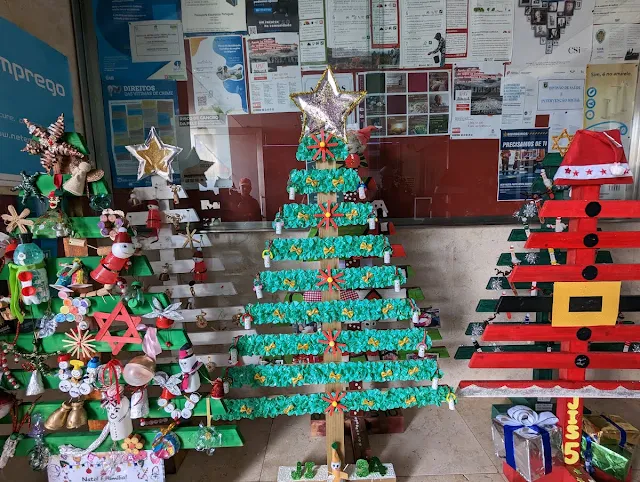
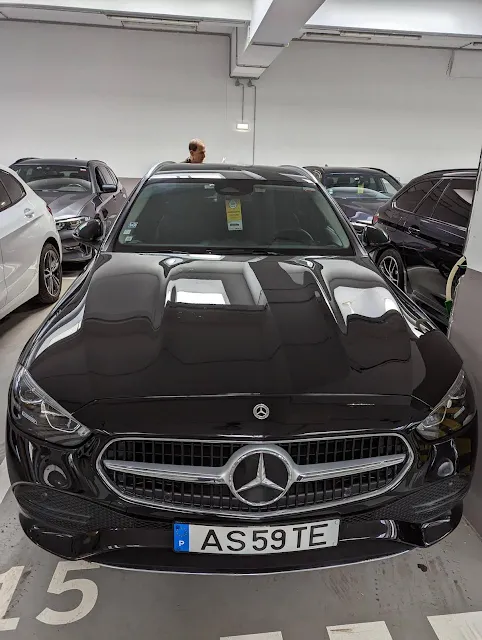



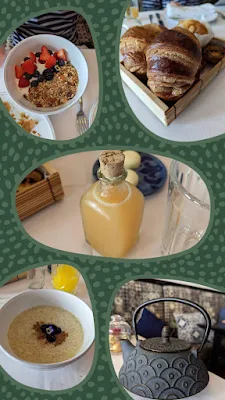
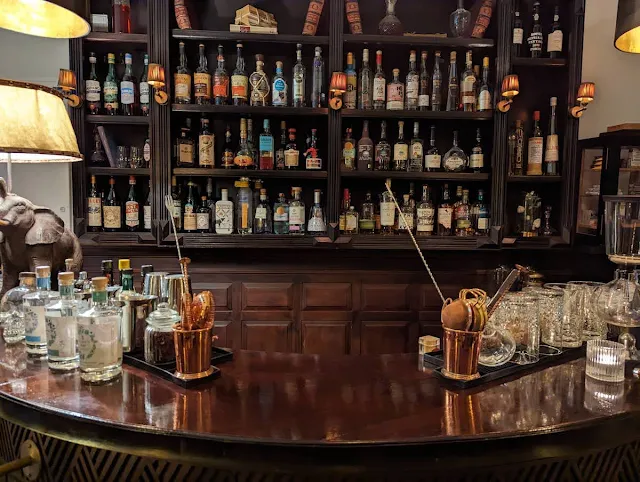

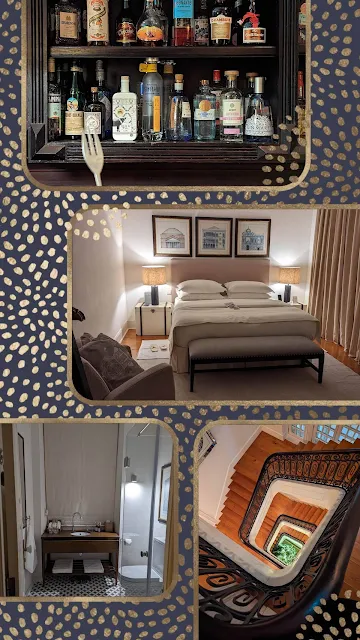
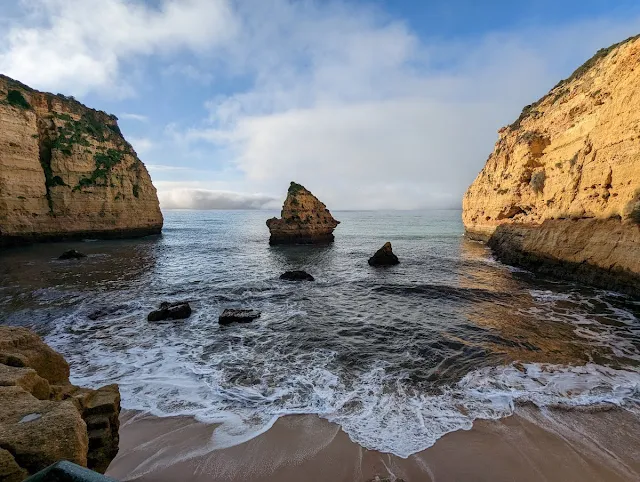

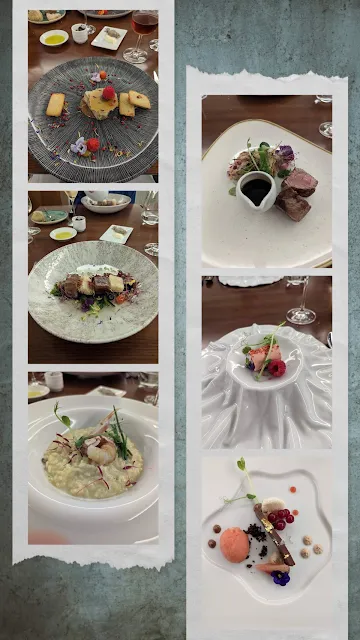
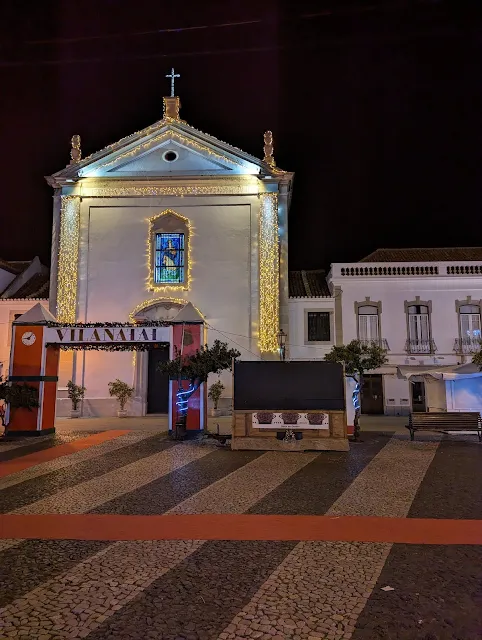

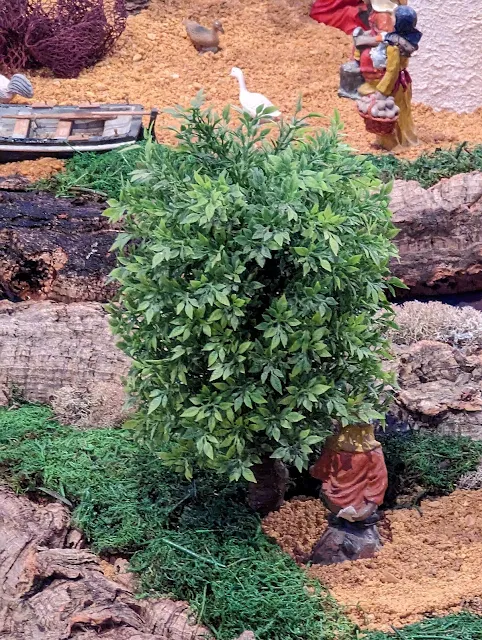
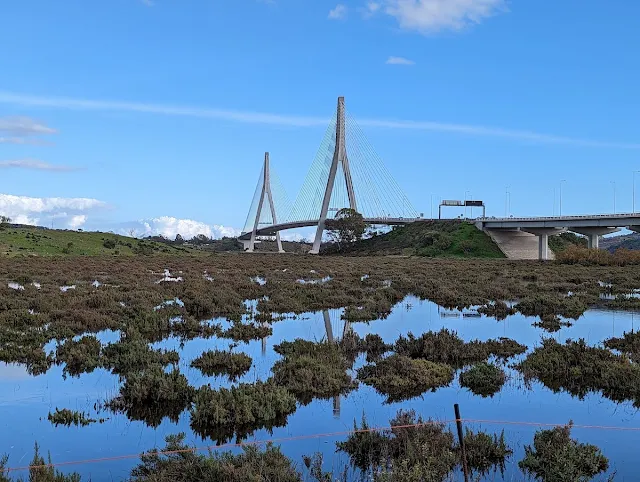


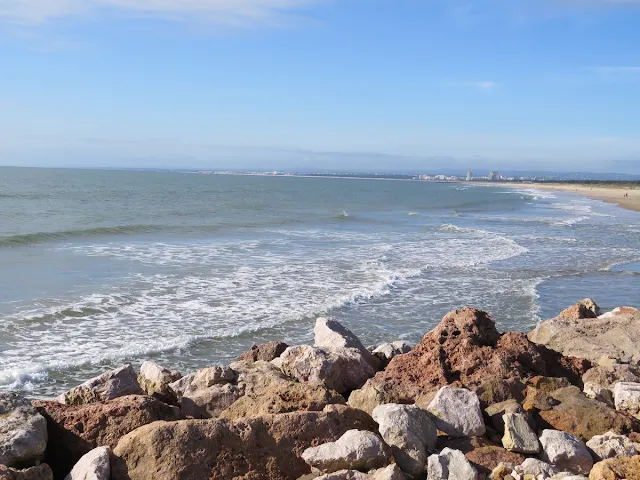

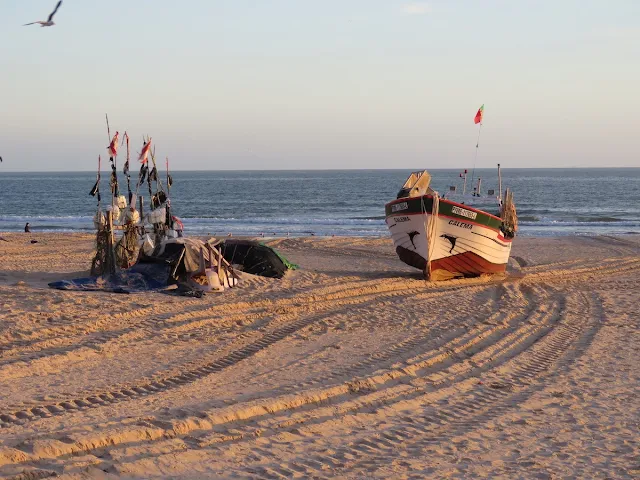

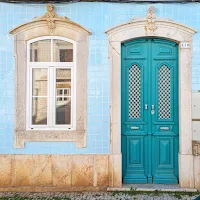



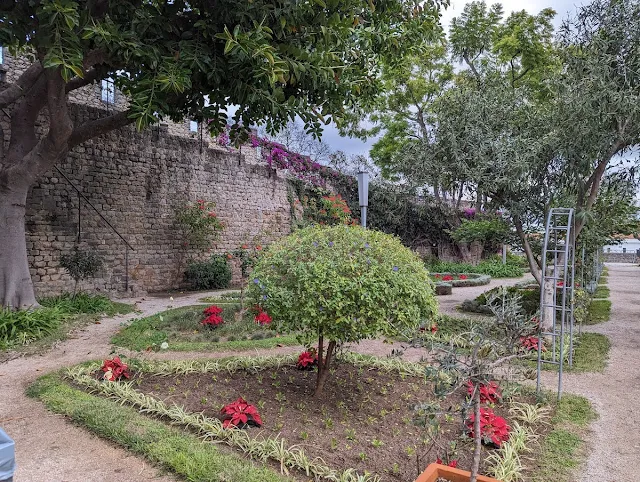
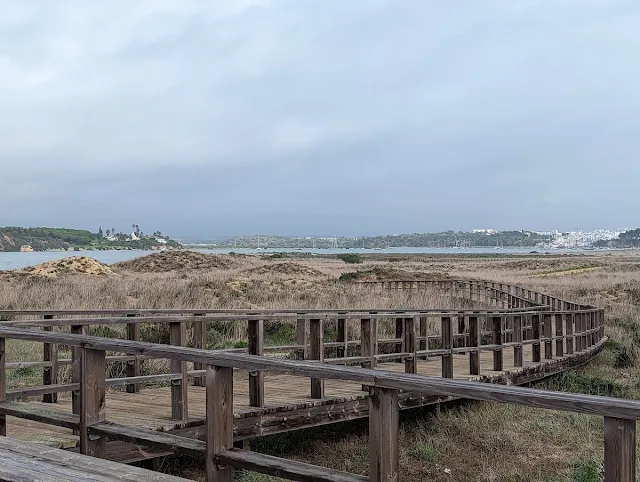



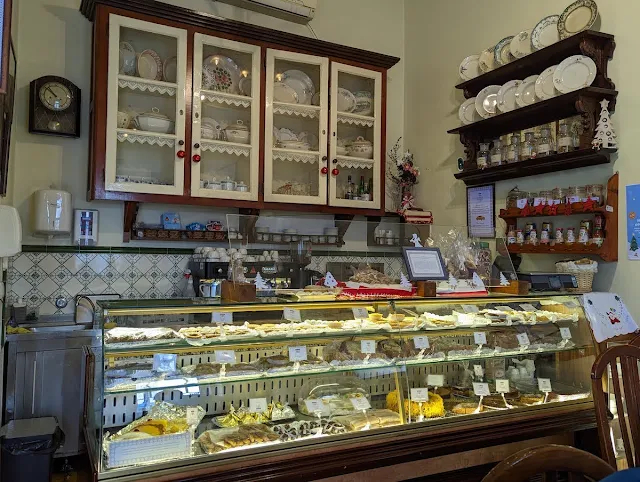

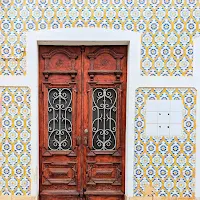



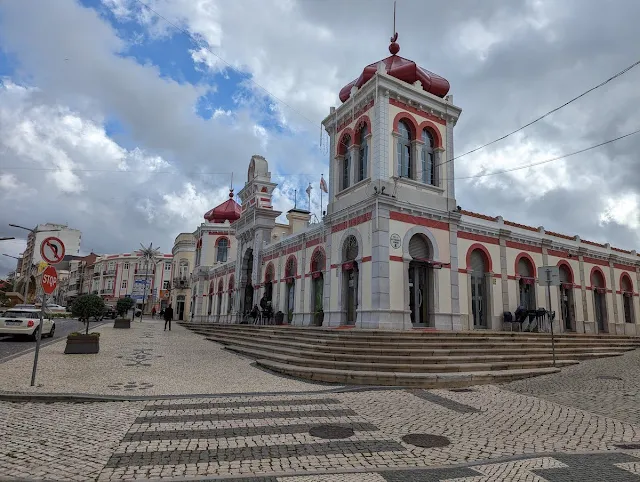



.jpg)
